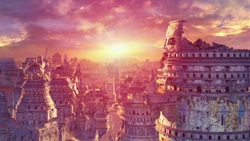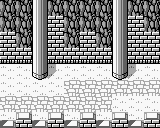Template:Sideicon

Zanarkand Ruins, one of the more famous ruins in the series.
Ruins (遺跡, Iseki?) are found across worlds in the Final Fantasy series as remains of ancient civilizations that fallen into a state of disrepair either through natural causes or by deliberate acts of destruction.
In most cases, these ruins indicated a certain level of technological advancement that have ceased to exist in, or is hidden from, the present society. Ruins play a varied role in the series - either to advance the plotline by, for example, revealing a machine that will further aid in the protagonist's quest, or to present backstories and offering optional subquests and powerful bosses for players to challenge their character's fighting capabilities.
Appearances
Final Fantasy III
The Ancient Ruins are attributed to the enigmatic race known as the Ancients. Here the ruins serve as an important plot location - housing an airship that will be used extensively by the party.
Final Fantasy IV
While not appearing the original version of Final Fantasy IV, the Lunar Ruins, first appearing in the Advance version, house an optional dungeon and is unlocked only by defeating the final boss.
Final Fantasy V
Among other ruins that appear in this title, the Ronka Ruins is most prominent for housing the Earth Crystal, which is worshiped by the ancient civilization of Ronka. The ruins is found floating in midair by the crystal's power, and despite being empty, still houses a working defense mechanism.
Final Fantasy VI
The World of Ruin is the remnants of the World of Balance thrown into disarray. Here, most towns have been obliterated through the heinous acts of the main villain Kefka, and society has crumbled in fear of the horrors unleashed.
Final Fantasy VII
Ancient and modern ruins exist in this title, found across the world. The existence of the ancient Cetra civilization is hinted at with the Temple of the Ancients; a maze-like complex inspired from Mayan designs, and the Forgotten Capital of the Cetra ruined by the appearance of Jenova.
After the events of Final Fantasy VII, the capital of Midgar was left as absolute ruin due to the dangers of Mako leaking from the reactors. Even before that, Midgar had already shown major signs of urban decay, such as the haunted Train Graveyard situated near the slums of Sector 7. Society had built itself a replacement city in Edge.
Final Fantasy VIII
The nomadic civilization of Centra left many settlements that grew into large cities. However, their capital was obliterated by the Lunar Cry and whatever remains became the Centra Ruins. This location serves for two optional sidequests for obtaining a Guardian Force.
Final Fantasy IX
The world of Gaia housed a number of ruins in its four continents, due to the failed planet-assimilation with Terra. The Mist Continent houses the Gargan Roo, an ancient underground tunnel that serves as a transportation network across the continent, and Fossil Roo that leads to the Outer Continent. Both of these are served by a Gargant, a large insect that travels the two Roos along the roots of the Iifa Tree.
The Outer Continent is home to the infamous ruins of Madain Sari, home to the obliterated race of summoners. The Forgotten Continent is another ruin hotspot that houses structures of Terran origin, Oeilvert and the so-called Ipsen's Castle.
Final Fantasy X
The appearance of many ruins marked a civilization that had transgressed its boundaries. The Zanarkand Ruins was once home to a civilization engaged in a Machina War against Bevelle. The war resulted in the creation of the creature known as Sin. Other ruins include the submerged island city of Baaj and the Omega Ruins that contains a powerful optional boss.
Final Fantasy X-2
Situated at the Calm Lands is an optional dungeon, the Ruin Depths. The dungeon serves for the game's chocobo raising sidequest.
Final Fantasy XI
Because of the age of the land of Vana'diel, many ruins can be found dotting the landscape. The Horutoto Ruins, Delkfutt's Tower, and Fei'Yin are ancient relics left behind by the Zilart and Kuluu people. The Ruins of Alzadaal are remnants of an ancient race found in the Near Eastern Empire of Aht Urhgan, spanning the underwater area between the mainland and the Arrapago Islands.
Final Fantasy XII
The ancient civilization of Galtea existed before the events of Final Fantasy XII, and left ruins across the region of Ivalice alongside lost and forgotten technology. The Tomb of Raithwall and the Stilshrine of Miriam are exclusive locations only accessible to blood members of the Dynast King Raithwall's legacy.
Final Fantasy XII: Revenant Wings
The Glabados Ruins in the island at the southern coast of Bervenia is home to a mysterious structure attributed to the predecessor of the aegyl race.
Final Fantasy XIII
The Hanging Edge, the area in which the game begins, is a ruined area once used as a residential area for the people of ancient Cocoon. During the War of Transgression, parts of Hanging Edge were damaged and exposed to the outside world, and as such the area has been declared off limits to the public.
In addition, far into the area of Lake Bresha, a ruined area used by people of Cocoon long past can be found. It is here that the party fights the Garuda Interceptor and secures an aircraft to help them escape.
Final Fantasy XIII-2
After the fall of Cocoon, The crystallized waters of Bresha have gone and now only the ruins remain. New tunnels were discovered since the fall and the ruins became an archaeological site for Academy with restricted passage for civilians. It is here that the party faces Atlas from a distant future. In 20 AF, ruins suffer sudden monster influx.
After Cocoon's second fall, Gran Pulse falls into ruin and two visitable areas from 700 AF—New Bodhum and A Dying World—are ruins of hometowns of two main characters of the game, Serah Farron and Noel Kreiss, respectively. Ruins of New Bodhum are small area and in the place where once a sea was, there's an endless plain of mushroom-shaped rocks, while A Dying World is a large valley with the ruins of a Farseer settlement to the east.
Lightning Returns: Final Fantasy XIII
The Dead Dunes are dotted with ancient ruins beneath its sands, mainly: Shrine of the Tablet: Atomos's Sands, Shrine of the Tablet: The Grave of the Colossi, and the Temple Ruins.
Final Fantasy XIV
The aftermath of Bahamut's rampage in the Calamity resulted in a number of ruins being unearthed throughout Eorzea. Some of the better known include the Sunken Temple of Qarn in Southern Thanalan and the Floating City of Nym in Outer La Noscea.
Final Fantasy Tactics A2: Grimoire of the Rift
The Ruins of Delgantua.
Final Fantasy Crystal Chronicles: Echoes of Time
The Ruins.
Final Fantasy Adventure
The Cave of Ruins is the only ruin in the game, the entrance to this place is blocked by a crystal in the Crystal Desert.
Final Fantasy Legend II
The Relics of the Ancient Gods is the only ruin in the game, its hidden inside South Forest on First World.
Final Fantasy Legend III
There are quite a few ruins found within the game. The first ruins the player comes across is the Northern Ruins found on the Floatland. The next set of ruins are found in Pureland, they are: Southwest Ruins and Eastern Ruins where the barrier machine is located.
Final Fantasy Airborne Brigade
Bravely Default
Gallery
Etymology
Ruins are the remains of human-made architecture: structures that were once complete, as time went by, have fallen into a state of partial or complete disrepair, due to lack of maintenance or deliberate acts of destruction.


